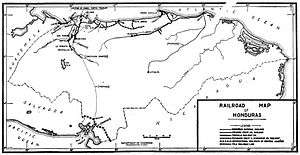Rail transport in Honduras
Railroads in Honduras were built in late 19th and early 20th centuries by two competing U.S. corporations - United Fruit (Tela Railroad Company) and Standard Fruit (later nationalized). All were in the Caribbean coastal area and never reached the capital. In 1993, the combined network had 785 km. At present (2006), only three separate segments remain in operation under the management of FNH - Ferrocarril Nacional de Honduras:
- San Pedro Sula - Puerto Cortes (50 km, freight trains carrying mainly lumber)
- City rail in La Ceiba (3 km, passenger transport between downtown and a western suburb, Col. Sitramacsa)
- Line between La Unión (a village near La Ceiba)[1] and Parque Nacional Cuero y Salado (9 km, transport of coconuts to a processing plant and of tourists to national park)
- In late 2010, a commuter/tourist train was established in San Pedro Sula.

History
The railroads in Honduras were originally built by banana companies and consisted of two separate systems with differing gauges. The larger system, with almost 600 kilometers (370 mi) of track, was built by Standard Fruit Company in the early 1900s. Half of this system was 3 ft 6 in (1,067 mm) narrow gauge; the other half consisted of 3 ft (914 mm) narrow gauge lines. The government nationalized the Standard Fruit line in 1983, renaming it the Honduras National Railroad (Ferrocarril Nacional de Honduras—FNH). The other system, owned by the Tela Railroad Company, a subsidiary of Chiquita Brands International, encompassed 190 kilometers (120 mi) of 3 ft 6 in (1,067 mm) narrow gauge lines. Both systems were located in the north central and northwestern coastal areas of Honduras and provided freight and passenger service.[2]
Transoceanic project
In 2013 it was announced that the Honduran Government and the China Harbour Engineering Company (CCEC) were interested in building a transoceanic railroad.[3]
See also
References
- Google. "La Unión" (Map). Google Maps. Google.
- from www.countrydata.com
- Rebecca Conan (June 21, 2013). "Chinese firm to develop US20bn Panama Canal alternative in Honduras". BN americas. Retrieved January 17, 2015.
External links
| Wikimedia Commons has media related to Rail transport in Honduras. |
- Unofficial timetables of Central American railroads
- Pictures from 2003, before suspension of passenger trains Puerto Cortés - Tela
- Overview of Honduras rail with contact addresses, pictures and external links
- More pictures from La Ceiba city rail (2005)